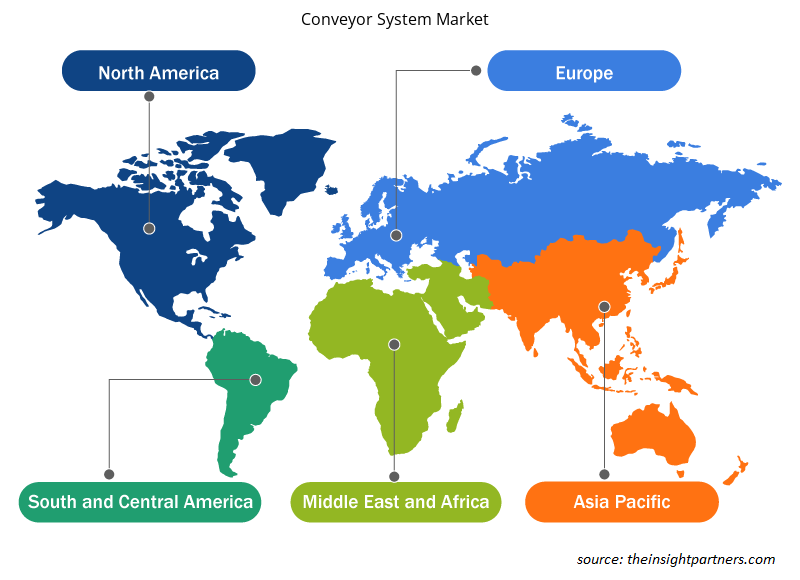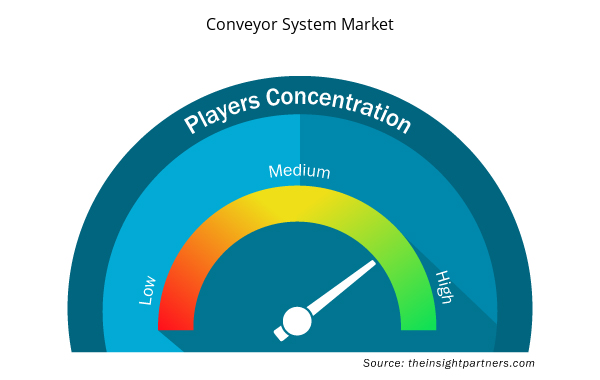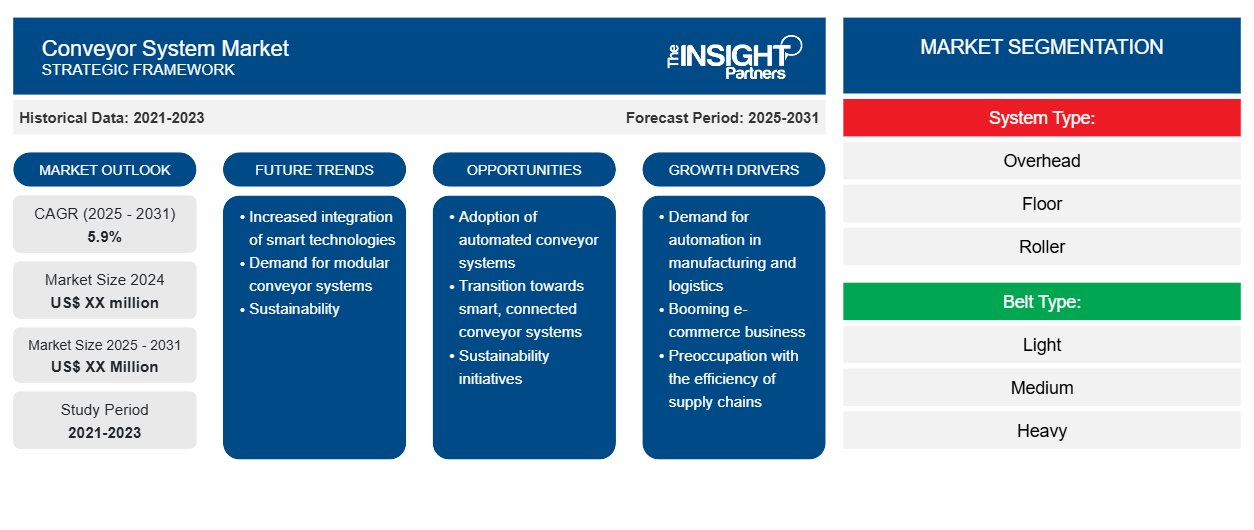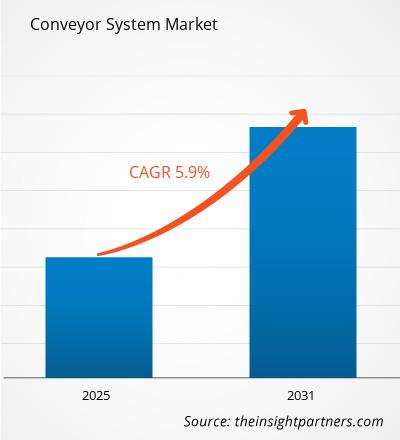Der Markt für Fördersysteme wird voraussichtlich von 2024 bis 2031 eine durchschnittliche jährliche Wachstumsrate (CAGR) von 5,9 % verzeichnen, wobei die Marktgröße von XX Millionen US-Dollar im Jahr 2024 auf XX Millionen US-Dollar im Jahr 2031 wachsen wird.
Dieser Forschungsbericht zum Markt für Fördersysteme enthält eingehende Analysen des Status und der Aussichten dieser recht wichtigen Branche und unterstreicht Trends und Chancen, die Marktsegmente voranbringen würden. Der Bericht kategorisiert den Markt nach Systemtyp, Bandtyp und Endverbraucherbranche und bietet so detaillierte Einblicke in Marktveränderlichkeit, Verbraucherpräferenzen und Konsummuster in verschiedenen Sektoren.
Diese Studie untersucht den Trend der Automatisierung in Fertigung und Logistik, der die Nachfrage nach Fördersystemen definiert, die die Effizienz und Produktivität von Abläufen verbessern. Sie untersucht verschiedene Fördertypen, darunter Band-, Rollen- und modulare Systeme, die in diversifizierten Branchen wie Automobil, Lebensmittel und Getränke, Lagerhaltung und Vertrieb eingesetzt werden.
Darüber hinaus umfasst die Segmentierung Einblicke in Branchen nach Endverbrauchern und zeigt, wie diversifizierte Anforderungen die Einführung von Förderlösungen beeinflussen. Darüber hinaus untersucht das Dokument die Verkaufskanäle, die Direktvertrieb, Distributoren und E-Commerce-Plattformen umfassen, die wirksame Strategien für die Marktdurchdringung und Kundenbindung aufzeigen würden.
Zweck des Berichts
Der Bericht „Conveyor System Market“ von The Insight Partners zielt darauf ab, die aktuelle Landschaft und das zukünftige Wachstum sowie die wichtigsten treibenden Faktoren, Herausforderungen und Chancen zu beschreiben. Dies wird verschiedenen Geschäftspartnern Einblicke geben, wie zum Beispiel:
- Technologieanbieter/-hersteller: Um die sich entwickelnde Marktdynamik zu verstehen und die potenziellen Wachstumschancen zu kennen, damit sie fundierte strategische Entscheidungen treffen können.
- Investoren: Durchführung einer umfassenden Trendanalyse hinsichtlich der Marktwachstumsrate, der finanziellen Marktprognosen und der Chancen entlang der Wertschöpfungskette.
- Regulierungsbehörden: Zur Regulierung von Richtlinien und Überwachungsaktivitäten auf dem Markt mit dem Ziel, Missbrauch zu minimieren, das Vertrauen der Anleger zu bewahren und die Integrität und Stabilität des Marktes aufrechtzuerhalten.
Fördersystem Marktsegmentierung
Systemtyp:
- Gemeinkosten
- Boden
- Rolle
- Gürtel
- Sonstiges
Riementyp:
- Licht
- Medium
- Schwer
Industrie:
- Essen & Getränke
- Automobilindustrie
- Flughäfen
- Logistik
- Metalle und Bergbau
- Sonstiges
Geographie
- Nordamerika
- Europa
- Asien-Pazifik
- Süd- und Mittelamerika
- Naher Osten und Afrika
Passen Sie diesen Bericht Ihren Anforderungen an
Sie erhalten kostenlos individuelle Anpassungen an jedem Bericht, einschließlich Teilen dieses Berichts oder einer Analyse auf Länderebene, eines Excel-Datenpakets sowie tolle Angebote und Rabatte für Start-ups und Universitäten.
- Holen Sie sich die wichtigsten Markttrends aus diesem Bericht.Dieses KOSTENLOSE Beispiel umfasst eine Datenanalyse von Markttrends bis hin zu Schätzungen und Prognosen.
Wachstumstreiber auf dem Fördersystemmarkt
- Nachfrage nach Automatisierung in Fertigung und Logistik: Es besteht eine steigende Nachfrage nach Automatisierung in Fertigung und Logistik. Automatisierte Fördersysteme sind zu einem unverzichtbaren Aspekt bei den Bemühungen der Unternehmen geworden, ihre Betriebseffizienz zu steigern und die Arbeitskosten zu senken. Dieser Aspekt ist in Branchen wie der Automobil-, Lebensmittel- und Getränke- sowie der Pharmaindustrie deutlicher zu erkennen, in denen optimierte Prozesse von entscheidender Bedeutung sind.
- Boomendes E-Commerce-Geschäft: Das Wachstum der Online-Käufe hat Unternehmen dazu veranlasst, massiv in die Lagerautomatisierung zu investieren, um die steigenden Bestellmengen unter Kontrolle zu halten und gleichzeitig die Erwartungen an längere Lieferzeiten zu erfüllen. In dieser Hinsicht bilden Fördersysteme den Kern der Logistikkette und ermöglichen es Unternehmen, Bestellungen viel schneller und mit einem höheren Grad an Genauigkeit zu sortieren, um die Kundenzufriedenheit trotz des harten Wettbewerbs aufrechtzuerhalten.
- Beschäftigung mit der Effizienz von Lieferketten: Diese Beschäftigung trägt zur weitverbreiteten Einführung von Fördersystemen bei. Die ständig wachsende Nachfrage der Verbraucher hat den Branchen bewusst gemacht, dass sie an der Optimierung der Produktionsabläufe arbeiten müssen. Daher sind Unternehmen in der Lage, ihre Materialhandhabung zu verbessern, betriebliche Engpässe zu reduzieren und die Produktivität durch den Einsatz von Förderlösungen zu steigern.
- Fortschrittliche Technologien: Die technologischen Fortschritte fördern weiteres Marktwachstum. Intelligente Technologien werden in die Prozesse von IoT und KI integriert, um Fördersysteme in Echtzeit zu überwachen und eine vorausschauende Wartung zu ermöglichen. Dies verbessert auch die Bedienbarkeit, sorgt für weniger Ausfallzeiten und ermöglicht einen reibungslosen und effektiven Geschäftsbetrieb.
Fördersystemmarkt: Zukünftige Trends
- Verstärkte Integration intelligenter Technologien: Technologien wie IoT und KI stellen wahrscheinlich einen der aktivsten Trends der letzten Jahre dar. Sie alle ermöglichen Echtzeitüberwachung, vorausschauende Wartung und Verbesserungen der Betriebseffizienz, sodass Unternehmen Prozessoptimierungen mit weniger Ausfallzeiten erreichen können.
- Nachfrage nach modularen Fördersystemen: Solche modularen Fördersysteme ermöglichen Flexibilität und Skalierbarkeit, sodass Unternehmen sich einfach und schnell an veränderte Produktionsanforderungen anpassen und ihre Betriebsabläufe skalieren können, ohne größere Umbauten vornehmen zu müssen. Daher wird eine solche Skalierbarkeit besonders in Branchen wie E-Commerce und Fertigung geschätzt, in denen die Anforderungen jederzeit schwanken können.
- Nachhaltigkeit: Auch Nachhaltigkeit ist ein wichtiger Schwerpunkt. Immer mehr Unternehmen suchen nach energieeffizienten Förderlösungen. Hersteller entwickeln umweltfreundliche Designs, die den Energieverbrauch und die CO2-Emissionen senken und damit den umfassenderen Nachhaltigkeitszielen der Unternehmen entsprechen.
Marktchancen für Fördersysteme
- Einführung automatisierter Fördersysteme: Unternehmen versuchen, ihre Effizienz zu steigern und ihre Betriebskosten zu minimieren. Dies wird besonders in Bereichen wie E-Commerce und Fertigung deutlich, wo die Auftragserfüllung sehr schnell erfolgen muss und die Prozesse so reibungslos wie möglich ablaufen müssen. Angesichts der Prognose, dass der E-Commerce-Umsatz bis 2024 die 6-Billionen-Dollar-Marke überschreiten wird, könnte der Bedarf an effizienten Materialhandhabungslösungen nicht größer sein.
- Übergang zu intelligenten, vernetzten Fördersystemen: Mit integrierten Technologien wie dem Internet der Dinge und künstlicher Intelligenz, die Echtzeitüberwachung und vorausschauende Wartung ermöglichen. Dies kann die Betriebseffizienz von Unternehmen deutlich verbessern und ihre Ausfallzeiten reduzieren. Der Markt für IoT in Fördersystemen soll kräftig wachsen – ein Merkmal, das das starke Interesse der Investoren an diesen Innovationen widerspiegelt.
- Nachhaltigkeitsinitiativen: Da die Industrie zunehmend auf die Reduzierung ihres ökologischen Fußabdrucks achtet, gewinnen energieeffiziente Förderlösungen an Bedeutung. Umweltfreundliche Systeme, die den Energieverbrauch senken, führen zu enormen Kosteneinsparungen und sind für Unternehmen attraktiv, die ihr Nachhaltigkeitsprofil verbessern möchten.
Regionale Einblicke in den Fördersystemmarkt
Die regionalen Trends und Faktoren, die den Fördersystemmarkt während des Prognosezeitraums beeinflussen, wurden von den Analysten von Insight Partners ausführlich erläutert. In diesem Abschnitt werden auch die Marktsegmente und die Geografie des Fördersystemmarkts in Nordamerika, Europa, im asiatisch-pazifischen Raum, im Nahen Osten und Afrika sowie in Süd- und Mittelamerika erörtert.

- Holen Sie sich die regionalspezifischen Daten für den Fördersystemmarkt
Umfang des Marktberichts über Fördersysteme
| Berichtsattribut | Details |
|---|---|
| Marktgröße im Jahr 2024 | XX Millionen US-Dollar |
| Marktgröße bis 2031 | XX Millionen US-Dollar |
| Globale CAGR (2025 - 2031) | 5,9 % |
| Historische Daten | 2021-2023 |
| Prognosezeitraum | 2025–2031 |
| Abgedeckte Segmente | Nach Systemtyp:
|
| Abgedeckte Regionen und Länder | Nordamerika
|
| Marktführer und wichtige Unternehmensprofile |
|
Dichte der Marktteilnehmer für Fördersysteme: Die Auswirkungen auf die Geschäftsdynamik verstehen
Der Markt für Fördersysteme wächst rasant, angetrieben durch die steigende Nachfrage der Endnutzer aufgrund von Faktoren wie sich entwickelnden Verbraucherpräferenzen, technologischen Fortschritten und einem größeren Bewusstsein für die Vorteile des Produkts. Mit steigender Nachfrage erweitern Unternehmen ihr Angebot, entwickeln Innovationen, um die Bedürfnisse der Verbraucher zu erfüllen, und nutzen neue Trends, was das Marktwachstum weiter ankurbelt.
Die Marktteilnehmerdichte bezieht sich auf die Verteilung der Firmen oder Unternehmen, die in einem bestimmten Markt oder einer bestimmten Branche tätig sind. Sie gibt an, wie viele Wettbewerber (Marktteilnehmer) in einem bestimmten Marktraum im Verhältnis zu seiner Größe oder seinem gesamten Marktwert präsent sind.
Die wichtigsten auf dem Fördersystemmarkt tätigen Unternehmen sind:
- Daifuku Co., Ltd.
- Dematic
- Emerson Electric Co
- Honeywell Intelligrated
- Interroll Holding GmbH
Haftungsausschluss : Die oben aufgeführten Unternehmen sind nicht in einer bestimmten Reihenfolge aufgeführt.

- Überblick über die wichtigsten Akteure auf dem Fördersystemmarkt
Wichtige Verkaufsargumente
- Umfassende Abdeckung: Der Bericht deckt die Analyse von Produkten, Dienstleistungen, Typen und Endbenutzern des Fördersystemmarktes umfassend ab und bietet einen ganzheitlichen Überblick.
- Expertenanalyse: Der Bericht basiert auf dem umfassenden Verständnis von Branchenexperten und Analysten.
- Aktuelle Informationen: Der Bericht stellt durch die Abdeckung aktueller Informationen und Datentrends Geschäftsrelevanz sicher.
- Anpassungsoptionen: Dieser Bericht kann angepasst werden, um spezifische Kundenanforderungen zu erfüllen und die Geschäftsstrategien optimal anzupassen.
Der Forschungsbericht zum Fördersystemmarkt kann daher dabei helfen, die Branchensituation und Wachstumsaussichten zu entschlüsseln und zu verstehen. Obwohl es einige berechtigte Bedenken geben kann, überwiegen die allgemeinen Vorteile dieses Berichts tendenziell die Nachteile.
- Historische Analyse (2 Jahre), Basisjahr, Prognose (7 Jahre) mit CAGR
- PEST- und SWOT-Analyse
- Marktgröße Wert/Volumen – Global, Regional, Land
- Branche und Wettbewerbsumfeld
- Excel-Datensatz



Report Coverage
Revenue forecast, Company Analysis, Industry landscape, Growth factors, and Trends

Segment Covered
This text is related
to segments covered.

Regional Scope
North America, Europe, Asia Pacific, Middle East & Africa, South & Central America

Country Scope
This text is related
to country scope.
Häufig gestellte Fragen
The report can be delivered in PDF/PPT format; we can also share excel dataset based on the request.
Some of the customization options available based on request are additional 3-5 company profiles and country-specific analysis of 3-5 countries of your choice. Customizations are to be requested/discussed before making final order confirmation, as our team would review the same and check the feasibility.
The market is expected to register a CAGR of 5.9% during 2023-2031
In a nutshell, the driving forces of the Conveyor System Market include demand from automation, growth in e-commerce, efficiency in supply chains, technological advancement, and environmental concerns. These factors together create a dynamic landscape that positions the market for continued growth in the coming years.
Increased automation of warehouses and distribution centers, therefore, drives investment in advanced conveyor technologies. Also, automated systems will be unavoidable to handle the increased volume of orders and for improving the efficiency of overall logistics. As these trends continue to evolve, the Conveyor System Market is poised for sustained growth, meeting the demands of a rapidly changing industrial landscape.
The key players in conveyor system market are - Daifuku Co Ltd, Dematic, Emerson Electric Co, Honeywell Intelligrated, Interroll Holding GmbH, Siemens AG, SSI Schafer, Swisslog Holding AG, TGW Logistics Group
Trends and growth analysis reports related to Manufacturing and Construction : READ MORE..
The List of Companies - Conveyor System Market
- Daifuku Co., Ltd.
- Dematic
- Emerson Electric Co
- Honeywell Intelligrated
- Interroll Holding GmbH
- Siemens AG
- SSI Schafer
- Swisslog Holding AG
- TGW Logistics Group
- Vanderlande Industries B.V
The Insight Partners performs research in 4 major stages: Data Collection & Secondary Research, Primary Research, Data Analysis and Data Triangulation & Final Review.
- Data Collection and Secondary Research:
As a market research and consulting firm operating from a decade, we have published and advised several client across the globe. First step for any study will start with an assessment of currently available data and insights from existing reports. Further, historical and current market information is collected from Investor Presentations, Annual Reports, SEC Filings, etc., and other information related to company’s performance and market positioning are gathered from Paid Databases (Factiva, Hoovers, and Reuters) and various other publications available in public domain.
Several associations trade associates, technical forums, institutes, societies and organization are accessed to gain technical as well as market related insights through their publications such as research papers, blogs and press releases related to the studies are referred to get cues about the market. Further, white papers, journals, magazines, and other news articles published in last 3 years are scrutinized and analyzed to understand the current market trends.
- Primary Research:
The primarily interview analysis comprise of data obtained from industry participants interview and answers to survey questions gathered by in-house primary team.
For primary research, interviews are conducted with industry experts/CEOs/Marketing Managers/VPs/Subject Matter Experts from both demand and supply side to get a 360-degree view of the market. The primary team conducts several interviews based on the complexity of the markets to understand the various market trends and dynamics which makes research more credible and precise.
A typical research interview fulfils the following functions:
- Provides first-hand information on the market size, market trends, growth trends, competitive landscape, and outlook
- Validates and strengthens in-house secondary research findings
- Develops the analysis team’s expertise and market understanding
Primary research involves email interactions and telephone interviews for each market, category, segment, and sub-segment across geographies. The participants who typically take part in such a process include, but are not limited to:
- Industry participants: VPs, business development managers, market intelligence managers and national sales managers
- Outside experts: Valuation experts, research analysts and key opinion leaders specializing in the electronics and semiconductor industry.
Below is the breakup of our primary respondents by company, designation, and region:

Once we receive the confirmation from primary research sources or primary respondents, we finalize the base year market estimation and forecast the data as per the macroeconomic and microeconomic factors assessed during data collection.
- Data Analysis:
Once data is validated through both secondary as well as primary respondents, we finalize the market estimations by hypothesis formulation and factor analysis at regional and country level.
- Macro-Economic Factor Analysis:
We analyse macroeconomic indicators such the gross domestic product (GDP), increase in the demand for goods and services across industries, technological advancement, regional economic growth, governmental policies, the influence of COVID-19, PEST analysis, and other aspects. This analysis aids in setting benchmarks for various nations/regions and approximating market splits. Additionally, the general trend of the aforementioned components aid in determining the market's development possibilities.
- Country Level Data:
Various factors that are especially aligned to the country are taken into account to determine the market size for a certain area and country, including the presence of vendors, such as headquarters and offices, the country's GDP, demand patterns, and industry growth. To comprehend the market dynamics for the nation, a number of growth variables, inhibitors, application areas, and current market trends are researched. The aforementioned elements aid in determining the country's overall market's growth potential.
- Company Profile:
The “Table of Contents” is formulated by listing and analyzing more than 25 - 30 companies operating in the market ecosystem across geographies. However, we profile only 10 companies as a standard practice in our syndicate reports. These 10 companies comprise leading, emerging, and regional players. Nonetheless, our analysis is not restricted to the 10 listed companies, we also analyze other companies present in the market to develop a holistic view and understand the prevailing trends. The “Company Profiles” section in the report covers key facts, business description, products & services, financial information, SWOT analysis, and key developments. The financial information presented is extracted from the annual reports and official documents of the publicly listed companies. Upon collecting the information for the sections of respective companies, we verify them via various primary sources and then compile the data in respective company profiles. The company level information helps us in deriving the base number as well as in forecasting the market size.
- Developing Base Number:
Aggregation of sales statistics (2020-2022) and macro-economic factor, and other secondary and primary research insights are utilized to arrive at base number and related market shares for 2022. The data gaps are identified in this step and relevant market data is analyzed, collected from paid primary interviews or databases. On finalizing the base year market size, forecasts are developed on the basis of macro-economic, industry and market growth factors and company level analysis.
- Data Triangulation and Final Review:
The market findings and base year market size calculations are validated from supply as well as demand side. Demand side validations are based on macro-economic factor analysis and benchmarks for respective regions and countries. In case of supply side validations, revenues of major companies are estimated (in case not available) based on industry benchmark, approximate number of employees, product portfolio, and primary interviews revenues are gathered. Further revenue from target product/service segment is assessed to avoid overshooting of market statistics. In case of heavy deviations between supply and demand side values, all thes steps are repeated to achieve synchronization.
We follow an iterative model, wherein we share our research findings with Subject Matter Experts (SME’s) and Key Opinion Leaders (KOLs) until consensus view of the market is not formulated – this model negates any drastic deviation in the opinions of experts. Only validated and universally acceptable research findings are quoted in our reports.
We have important check points that we use to validate our research findings – which we call – data triangulation, where we validate the information, we generate from secondary sources with primary interviews and then we re-validate with our internal data bases and Subject matter experts. This comprehensive model enables us to deliver high quality, reliable data in shortest possible time.


 Holen Sie sich ein kostenloses Muster für diesen Bericht
Holen Sie sich ein kostenloses Muster für diesen Bericht